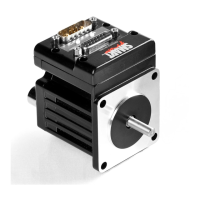Moog Animatics SmartMotor™ Developer's Guide,Rev. L
Page 874 of 909
Moment of Inertia
A basic understanding of Moment of Inertia serves well in ensuring proper SmartMotor™
sizing. It is one thing to look at static points on torque curves, but it is altogether different
when considering the dynamic aspects of loads being accelerated at high rates.
l
The inertial mass of an object is a measure of its resistance to a change in its velocity.
l
The Moment of Inertia of an object is at a point of reference of rotation, which is at the
pivot point or axis of rotation.
l
The Moment of Inertia can, therefore, be thought of as a measure of the resistance to
any change in rotational speed.
For linear systems, the rate of change of speed (acceleration) is proportional to the force
applied. Double the mass requires double the force to achieve the same acceleration.
Similarly, for rotational systems, the angular acceleration of the load is proportional to the
torque applied. Double the Moment of Inertia and the torque needs to be doubled for the same
angular acceleration. Moment of Inertia is, therefore, a measure of a load’s resistance to
angular speed change, or how much effort (torque) is required to cause acceleration or
deceleration.
Matching Motor to Load
A common rule of thumb for SmartMotor sizing is that the load should have no more than ten
times the Moment of Inertia of the motor rotor that is driving it. This provides a good starting
point and typically allows for safe sizing over a wide range of applications.
A rotating load wants to maintain the same velocity. Therefore, when a motor attempts to
accelerate the load, it must overcome the Moment of Inertia of that load by applying
additional torque to increase the speed. As a result, it takes more torque to change speed than
it does to maintain a given speed.
In the same manner, for the motor to decelerate the load, the load’s Moment of Inertia wants
to keep the motor going the same speed and will, in effect, back-drive the motor, which turns
it into a generator.
CAUTION: In extreme cases, back-drive can result in overvoltage damage to
the motor's drive stage.
Improving the Moment of Inertia Ratio
Adding gear reduction to a motor gives it more leverage to prevent back-driving and also
provides an advantage in accelerating a load up to speed.
Any given change in gear reduction results in a proportional change in speed and static torque,
but results in a squared change in acceleration and dynamic rate of change of torque. The
result is that by adding gear ratio you gain a squared decrease in the ratio of Moment of
Inertia between motor and load.
Therefore, through gear reduction, the motor has a greater advantage in both accelerating
and decelerating the load. Gear reduction adds protection against damage to the overall
system.
Appendix: Moment of Inertia

